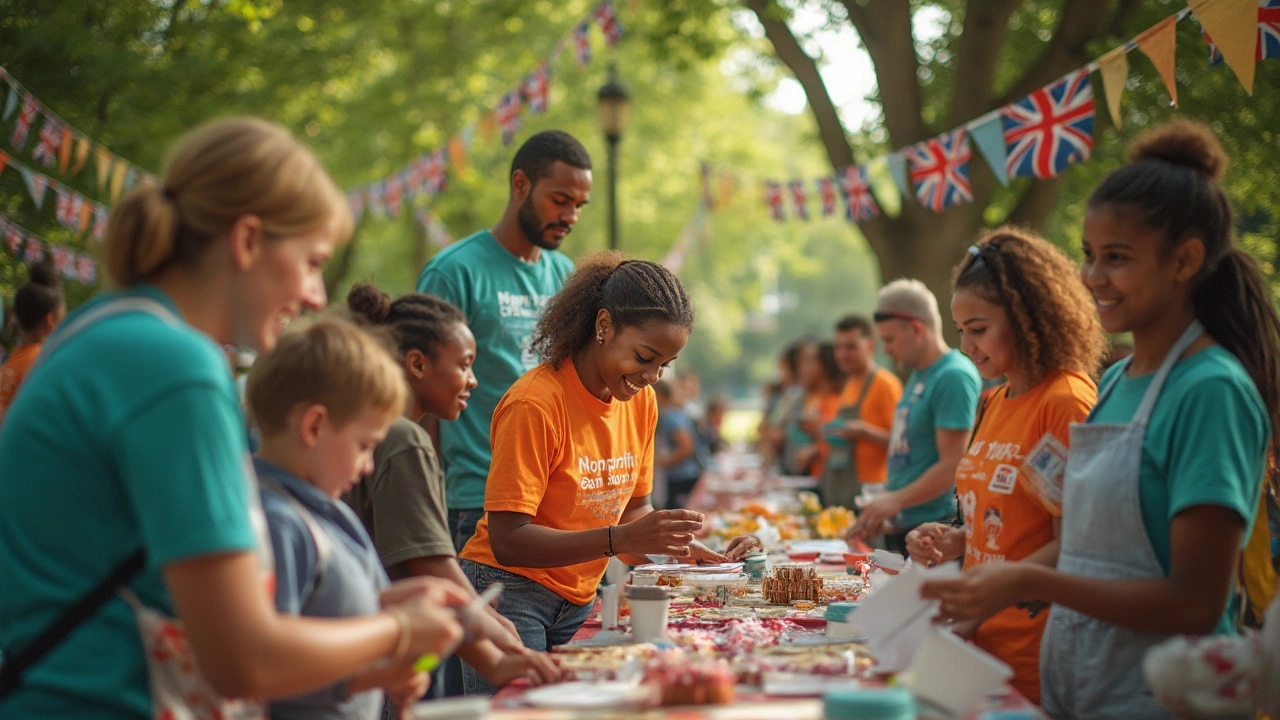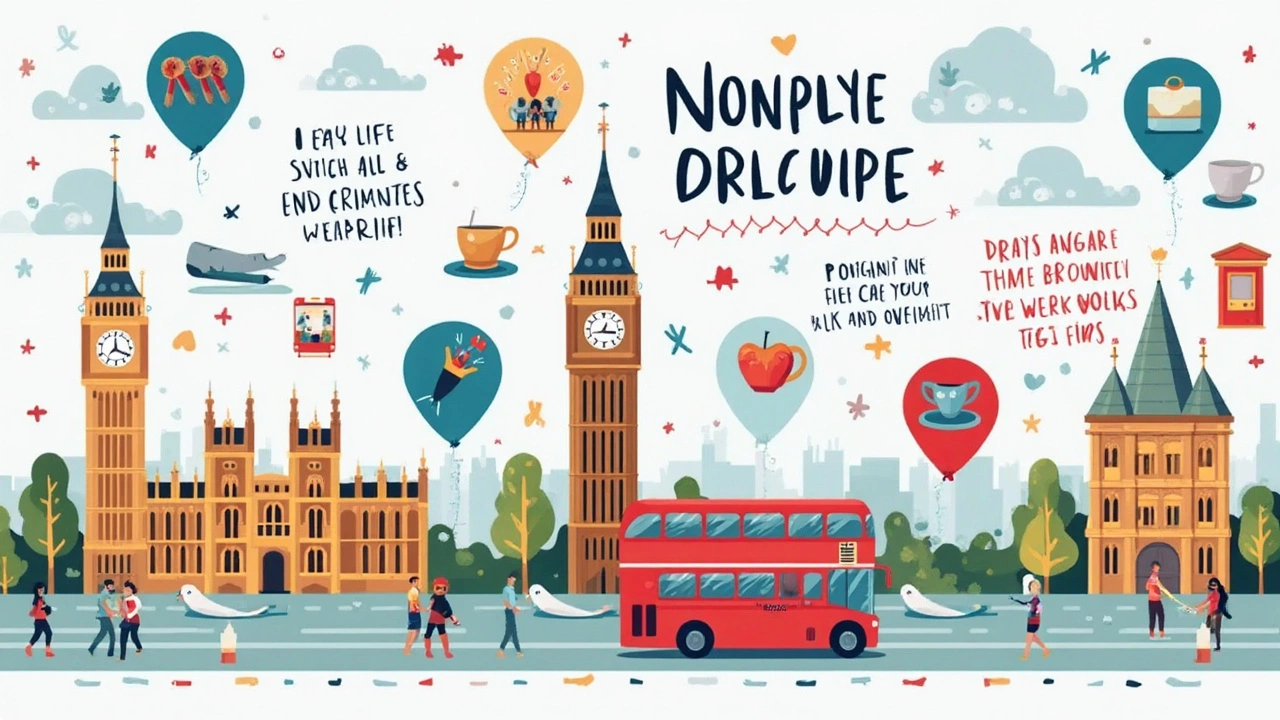Nonprofit Activity: What It Really Means for Charity Events
 May, 4 2025
May, 4 2025
So, what actually makes an activity a "nonprofit" one? It’s not just about raising money for a good cause. Nonprofit activities are organized to help people or address problems—think sharing food at a shelter, hosting free community classes, or running events to raise awareness. The big thing is, any money raised goes straight into supporting the mission, not into someone’s pocket. That’s why your favorite charity run or bake sale at the local animal shelter fits the bill.
The lines get blurry sometimes. Not every event with a “charity” label counts. Look for clear connections: is the event run by a registered nonprofit group, or does the money go directly to helping people or causes (not to private owners or friends of the organizer)? Checking for this upfront can save you from supporting something that’s just charity in name only.
- What Makes an Activity Nonprofit?
- The Rules and Guidelines Behind Nonprofit Events
- Real-Life Examples You’ll Recognize
- Why Getting Involved Matters
- Quick Tips for Supporting Nonprofit Activities
What Makes an Activity Nonprofit?
A nonprofit activity is all about serving others or fixing a problem, not bringing in profit for whoever's running the show. The main goal is helping people, animals, or even the planet. So instead of trying to make money for investors or business owners, every dollar earned or raised gets funneled right back into making things better.
This means that if you’re buying cookies at a fundraiser, signing up for a fun run, or donating your time at a food drive, you’re part of a nonprofit activity if the money goes straight toward charity work, not someone's personal bank account. It’s easy to mix up nonprofit events with for-profit ones, so here are some dead giveaways that you’re really looking at a nonprofit deal:
- The event is organized by a registered nonprofit, like a 501(c)(3) in the U.S.—that’s an official label for groups that don’t pay taxes because all their extra cash goes to their cause.
- There’s total transparency on where the money is going. You don’t have to dig for answers—the info is clear and public.
- Staff and volunteers aren’t in it for big paychecks. Sure, some jobs pay, but most folks are there because they care or want to help out.
- The focus is always on a public benefit: helping folks in need, funding research, cleaning parks, supporting health programs, and so on.
You’ll find these activities at charity events like walkathons, fundraising dinners, and volunteer clean-up days. Want proof? In 2023 alone, Americans gave over $499 billion to nonprofits (Giving USA report). The biggest chunk went to activities fighting big challenges like hunger, education gaps, and medical research.
| Nonprofit Activity | Purpose |
|---|---|
| Charity Run | Raise funds for medical research or social programs |
| Soup Kitchen Volunteering | Feed people in need, no cost to them |
| Book Drive | Collect books for literacy programs |
The points above give you a solid way to spot a true nonprofit activity. If you’re still not sure, just ask: "Where does the money go?" If the answer is all about helping, you’re in the right place.
The Rules and Guidelines Behind Nonprofit Events
It’s easy to think any event that sounds good must be following the rules, but nonprofit activity comes with its own set of boundaries. The first big thing: a legit nonprofit event must be run by a registered nonprofit group, which in the US usually means they’re a 501(c)(3) organization. That’s the IRS code for most charities, schools, and foundations. If you ever see that number, you know the group had to jump through some legal hoops to get it.
Money is another huge sticking point. Every single dollar raised at a true nonprofit event has to go back into helping the cause. Organizers can use it for staff, supplies, overhead, or direct services—but absolutely none of it is allowed as personal profit. If someone’s driving a fancy new car thanks to last month’s bake sale, run the other way.
There are IRS rules about what counts as a legitimate expense, and events must keep receipts and records in case anyone (especially donors or tax authorities) asks to see them. For charity events where people get something back—like a dinner or a concert ticket—organizers are supposed to clearly state what part of your ticket is a tax-deductible donation, and what’s just covering the cost of your meal or show.
Here’s a simple list of the basics every nonprofit event should follow:
- Be hosted by a registered nonprofit organization (check IRS or state databases if you’re not sure).
- Announce exactly which cause or project the funds support.
- Be upfront about how much of your ticket or donation actually goes to the cause.
- Provide written receipts for donations that are $250 or more (that’s IRS law).
- Be transparent—good groups are happy to answer questions about budgets or programs.
According to the National Philanthropic Trust, in 2024, over 63 million Americans volunteered time and services for charity events and nonprofit projects. Events that follow these guidelines make it simple for volunteers and donors to know their support is legit and going where it should.

Real-Life Examples You’ll Recognize
If you've ever taken part in a charity marathon, donated to a public radio station, or seen holiday toy drives at your grocery store, you’ve already brushed up against classic nonprofit activity. These are everywhere once you start paying attention. Let’s break down a few types you probably know:
- Charity Runs & Walks: Think of events like the Susan G. Komen Race for the Cure or Relay for Life. These big gatherings get communities moving and raise millions for research and support. All the money after covering basic event costs goes back to the cause.
- Food Drives: During Thanksgiving or disaster response, organizations like Feeding America and local churches collect canned goods to distribute to folks who need help most. No profit here; it’s pure impact.
- Benefit Concerts: These events, from Live Aid in the ‘80s to local outdoor shows, bring together musicians for a cause. Ticket sales and donations support the featured charity, whether that’s relief funds or children’s health.
- Community Clean-Ups: When groups like Keep America Beautiful gather people to clean up beaches or parks, the only goal is better neighborhoods—not profit.
Here’s something that might surprise you: In the US, over 1.5 million registered nonprofit organizations run events like these every year. According to a recent study, charitable giving in 2023 reached $557 billion. That means your time or $20 ticket is part of a massive engine for good.
It’s not just the national stuff, either. Your kid’s school bake sale or that local animal shelter open house? If they’re run by a group with nonprofit status and all proceeds serve the mission, those count as true nonprofit activities too. So, next time you spot one of these events, you’ll know exactly how your support fits into the bigger picture.
Why Getting Involved Matters
Diving into a nonprofit activity isn’t just a good deed—it actually changes things in ways you might not expect. Studies from the Johns Hopkins Center for Civil Society show that volunteering and participating in charity events builds strong social networks and boosts community health. Even if you don’t have cash to give, just showing up and helping out can multiply the impact of every dollar raised.
Lots of folks find their own lives improving after volunteering. According to data from the Corporation for National and Community Service, people who participate in nonprofit organizations are about 27% more likely to get a job after being out of work compared to non-volunteers.
Here’s something to think about: local causes get most of their help from people like you. That fun run for cancer support? If enough neighbors don’t help, it doesn’t happen. Small-town animal rescues would vanish overnight if everyone waited for others to step up.
"The heart of the nonprofit world beats because of ordinary people pitching in with whatever time, skills, or dollars they have." – National Council of Nonprofits
Getting involved goes way beyond just writing a check. When you put your energy into volunteering or help organize fundraising efforts, your local area becomes safer, healthier, and even happier. Lots of studies link high levels of community volunteering with lower crime and higher school success. In short, your effort isn’t just a nice add-on—it’s critical.
| Type of Involvement | Direct Impact |
|---|---|
| Joining a fundraising walk | Funds medical research, makes support groups possible |
| Sorting donations at a food bank | Keeps shelves stocked for hungry families |
| Helping at animal shelters | Saves more animals, increases adoptions |
Anyone can get involved, and the ripple effects are pretty amazing. Whether you’re donating time, skills, or money to nonprofit activity, you help your own community stay strong and resilient. And who knows, you might make some friends along the way.

Quick Tips for Supporting Nonprofit Activities
Supporting nonprofit activity isn’t just about giving money at the check-out counter. You can make a bigger impact by picking the right activities and using a few smart moves. If you’re ever stuck, think practical—what will actually help the group or the cause?
- Do your homework: Before signing up for a charity event, check if it’s run by a registered nonprofit. You can look them up on sites like Guidestar or Charity Navigator. This helps you avoid scam events or ones where the money never reaches those in need.
- Volunteer your time or skills: Many nonprofits need more than just cash—they need people. Whether that’s helping set up tables at a food drive, using your graphic design skills for their social media, or handing out water at a charity run, your time can be just as valuable as your wallet.
- Spread the word: Sometimes, the best thing you can do is get loud about the cause on social media or in your group chats. Nonprofits rely on word-of-mouth to grow support, especially for special charity events.
- Set up recurring donations: If you’re able, even small monthly donations give nonprofits steady support. According to the Nonprofit Source 2024 study, recurring givers donate 42% more per year compared to one-time donors. That adds up and gives organizations room to plan.
- Ask where your contribution goes: Don’t be shy or afraid to ask. Reputable organizations are happy to show you exactly how your money or time makes a difference. Transparency is a green flag for real nonprofit organizations.
| Way to Support | What It Does | Bottom Line |
|---|---|---|
| Volunteering | Saves nonprofits money & brings in needed skills | High impact, no money needed |
| Monthly Giving | Provides steady support | Keeps organizations running smoothly |
| Spreading Awareness | Attracts more supporters | Big results from simple actions |
One last tip: stay skeptical, but hopeful. There’s a quote from the National Council of Nonprofits that sticks with me:
“Even small actions, when shared by many, create lasting impact for our communities.”So whether you’re giving five bucks or reposting a fundraiser, know your support goes further than you think.
